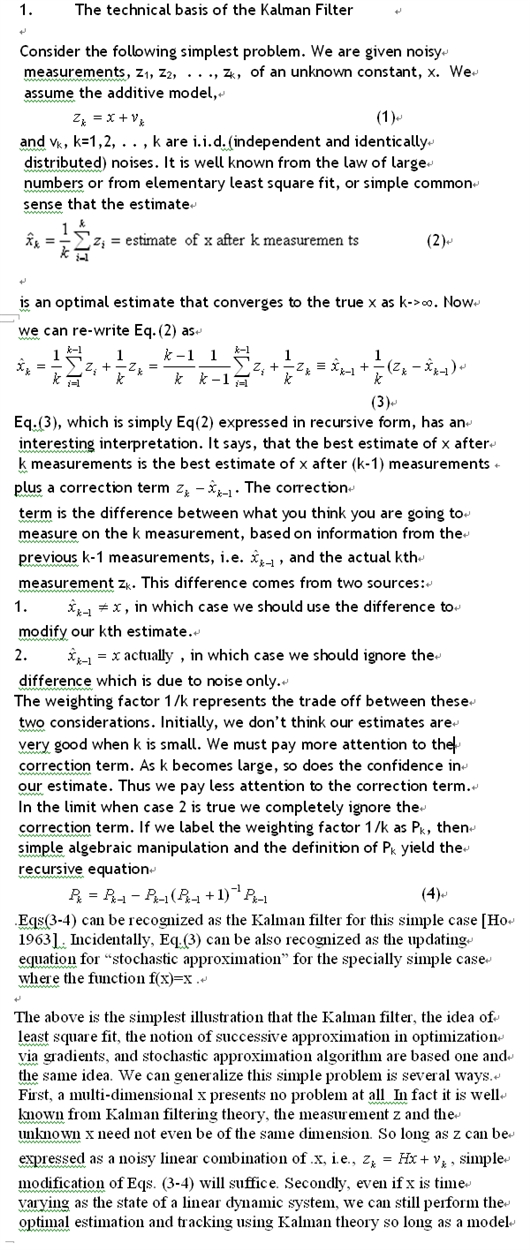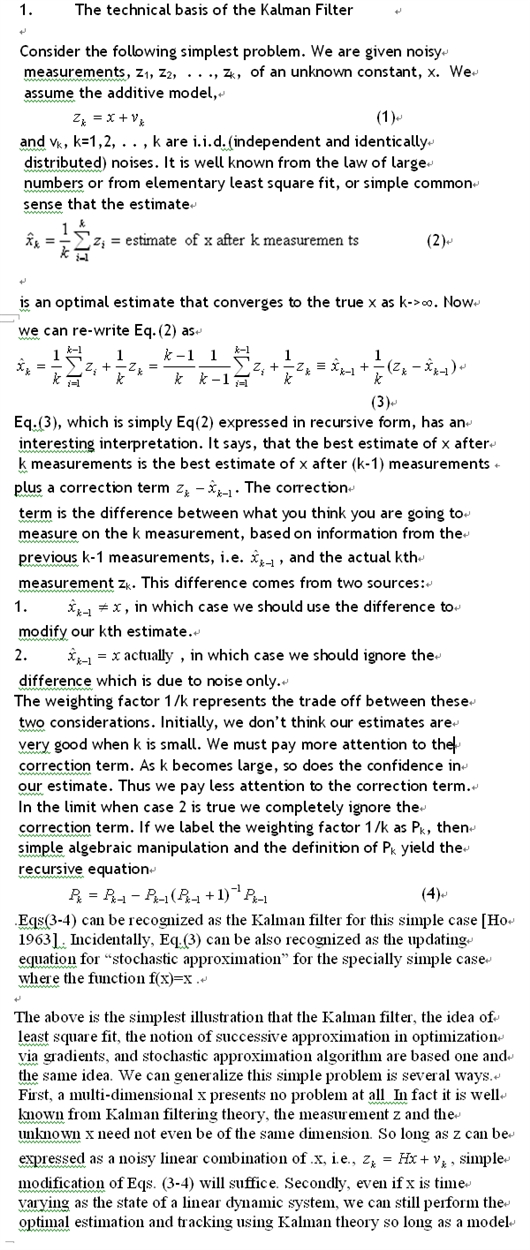博文
Proximity to Fame (#2) - the 2008 Draper Prize
|
(For new reader and those who request 好友请求, please read my 公告栏 first)
(1/10/08) Proximity to Fame (#2) The Draper Prize (Nobel for Engineering)
for 2008 – the Kalman Filter : a technical explanation and personal
account of its history
I must be prescient. In my June 21, 2007 blog article : On Prizes,
Nobel and others,
http://sciencenet.cn/blog/user_content.aspx?id=3574 I predicted
that Dr. Rudolf E. Kalman should win the Draper Prize given by
the National Academy of Engineering (NAE) of the US
sometimes in the future. Little did I know that my prediction
became true almost immediately as announced today by the
US National Academy of Engineering. Kalman filter arguably
is the crowning achievement of modern system and control theory.
It is behind almost every aerospace guidance and control systems,
the ubiquitous GPS unit in most automobiles and everywhere
else, and countless industrial applications. Yet its principle goes
way back to the least square method of Gauss, the famous
mathematician of 18th century, and the ancient civil engineering
method of triangulation for position determination. Except the Kalman
filter takes this principle to such a sophisticated degree that even
today most students who learn about the Kalman filter are
unaware of this fundamental connection.
Thus let me first give a simple intuitive explanation of this
connection or the Kalman filter derived using only high school
algebra. (Readers interested only in the historical and
humanistic aspect of this account can skip the next section and go
directly to the history section. 

of the dynamic system existed. In fact, the essence of the Kalman theory
can be captured by the sentence: ”subtract out every known effect and
average the left over.” This is the only thing and the best thing that can
be done. Kalman filter is simply a mathematical implementation of the
above sentence, a glorified least square fit and an ultra sophisticated
application of the law of large numbers. On probabilistic basis, a very
satisfying Baysean decision-theoretic interpretation is also possible. For
details, consult [Ho & Lee 1965]
2. A personal account of the history of the Kalman filter
During the decade of the Fifties, network theory was the dominant theory
of theoretical electrical engineering. Implementing the Wiener filter
using network theory was a crowning achievement. But practically it
was a difficult thing to do involving using frequency domain techniques
to solve the Wiener-Hopf integral equation. Furthermore, the extension
to time varying linear network was considered to be nearly impossible. I
was a graduate student in 1959 at Harvard. IEEE has a Western
Regional conference named WESCOM at that time. One of the people
in my lab at Harvard attended the conference and came back to report an
interesting incident. Sydney Darlington, a giant in network theory from
Bell Labs at that time, was given a talk on time varying Wiener filter at
the conference. At the conclusion of his talk, a young man from the
audience (that was Kalman then unknown to the world) came up and
told the audience that the approach by Darlington and others are all
misguided. And he has the correct solution much more general and practical.
Of course, the audience and everyone thought what a crazy and arrogant
young man to make such claims and to be so impudent to challenge an
expert. The whole incident was dismissed as amusing but insignificant.
But by hindsight at that time Kalman had already worked out a discrete
time (sampled-data) version of the filter and had his paper accepted for
publication [Kalman 1960]. A year later, for part of my ph.d thesis, I
discovered what then known as the Kalman-Betram condition for dead
beat control was in fact a condition of linear independence of vectors. I
wrote up the paper and submitted it for publication and presentation at
the first American control Conference at MIT 1960. The paper was
accepted and schedule to be presented at a session on new approaches to
control. At the same session there was a paper by Kalman and Bucy on
the continuous time version of the Kalman filter featured as the last
presentation of the session. Frankly, very few person if any understood
the significance of the Kalman-Bucy filter. Fred Butler, another expert
on Wiener filter at that time , got up from the audience and had a long
and involved arguments with Kalman which I don’t think anyone
understood at the time. However, the main point of discussion was
whether or not using time domain differential equation and digital
computer was the right approach to do filtering and estimation. Years
later this would seems to be a silly argument. But such incident of
disagreement between the “classical” and the “modern” theory of
control in the late Fifties and early Sixties were numerous. Science by
nature is very conservative. Breakthroughs are difficult for the
“establishment” to accept (and for largely good reasons). Young
scholars unburdened by being brainwashed by the established party line
are often among the first to accept new ideas. To be fair historically,
other people had somewhat similar ideas at that time. Peter Swerling, R.
Battin, A.E. Bryson had some versions of the K-filter in their papers.
But it is generally agreed that no one visualized the filter in all its
generality as Kalman did and understood its full significance. In 1963
Kalman wrote an unpublished report (at the place he was working,
called the Research Institute of Advance Study RIAS established by The
Martin Aircraft Company) known as the RIAS report to people in the
“know” which was essentially the last word on the subject.
For my own part, after I wrote about the Kalman-Betram condition for
dead beat control, Kalman invited me to visit RIAS for six weeks and to
work with him. As a new and young scholar just starting out, I was very
much flattered by the attention. At RIAS during the fall of 1961, I tried
to understand the filtering paper of Kalman. It was difficult going. But I
finally understood the essence in the spirit of section one above and
wrote my1963 paper [Ho 1963] during my 1962 summer job at the RAND
corporation. Later on in teaching a course on decision theory I made the
connection with Bayesian decision analysis which provided an unified
and probabilistic explanation for both linear and nonlinear filtering
[Ho and Lee 1964]. In the ensuing half century numerous tutorial and
other papers relating to the Kalman filter have been written including
Kalman’s own account celebrating the fortieth anniversary of its invention
[Kalman 2003 ]..
Ever since the establishment of the Draper prize by the NAE in 1989, I
have maintained that Kalman is a deserving recipient. It is satisfying
that he is being recognized. The award ceremony will be on February 19,
2008 in Washington DC. Kalman invited me to be there and I am looking
forward to the occasion. It will be my closest brush with a “Nobel” ceremony.
Y.C. Ho, “On Stochastic Approximation Methods and Optimal
Filtering” J. of Math Anal. and Application , Vol. 6, No. 1, Feb.
1963, pp 152-154.
R.E. Kalman, Y.C. Ho, and K.S. Narendra, “Controllability of
Linear Dynamical Systems” Contributions to Diff. Equation. ,
Vol. I, Interscience , 1963, pp 189-213.
Y.C. Ho and R.C.K. Lee, “A Bayesian Approach to Problems in
Stochastic Estimation and Control” , IEEE Trans. on Automatic
Control , Vol. 9, Oct. 1964, pp 333-339
R.E. Kalman, “A New Approach toLinear Filtering and
Prediction Problems”,Transactions of the ASME–Journal of
Basic Engineering, 82 (Series D): 1960, 35-45.
R.E. Kalman, “Discovery and Invention: The Newtonian Revolution in
System Technology“, Journal of Guidance and Dynamics, Vol 26, #6,
Nov-Dec. 2003, pp1-7
More information can be found at
http://nae.edu/nae/awardscom.nsf?OpenDatabase
https://blog.sciencenet.cn/blog-1565-14253.html
上一篇:The USElection and the New Hampshire Primary
下一篇:Chinese American Weddiung (#2)